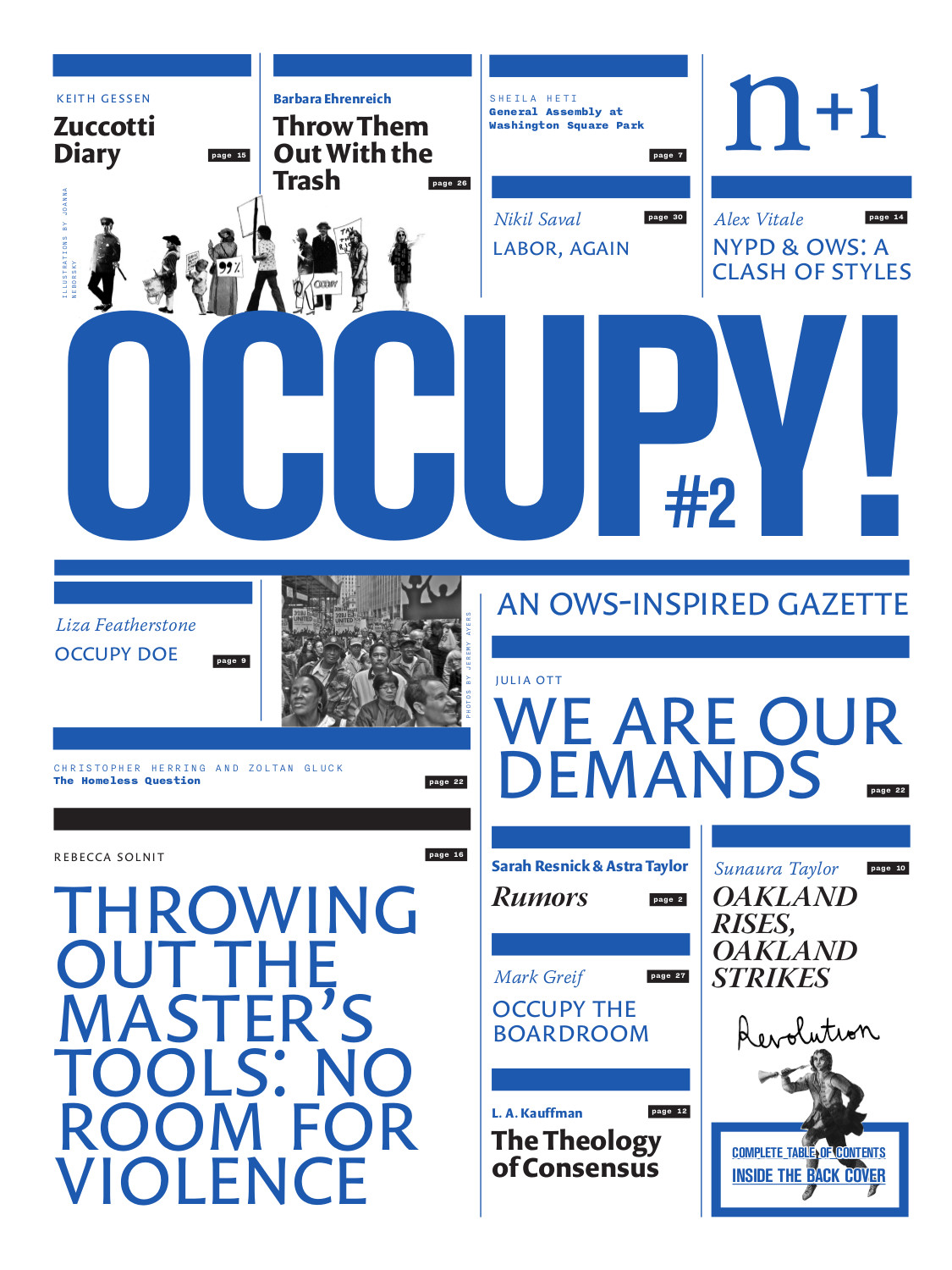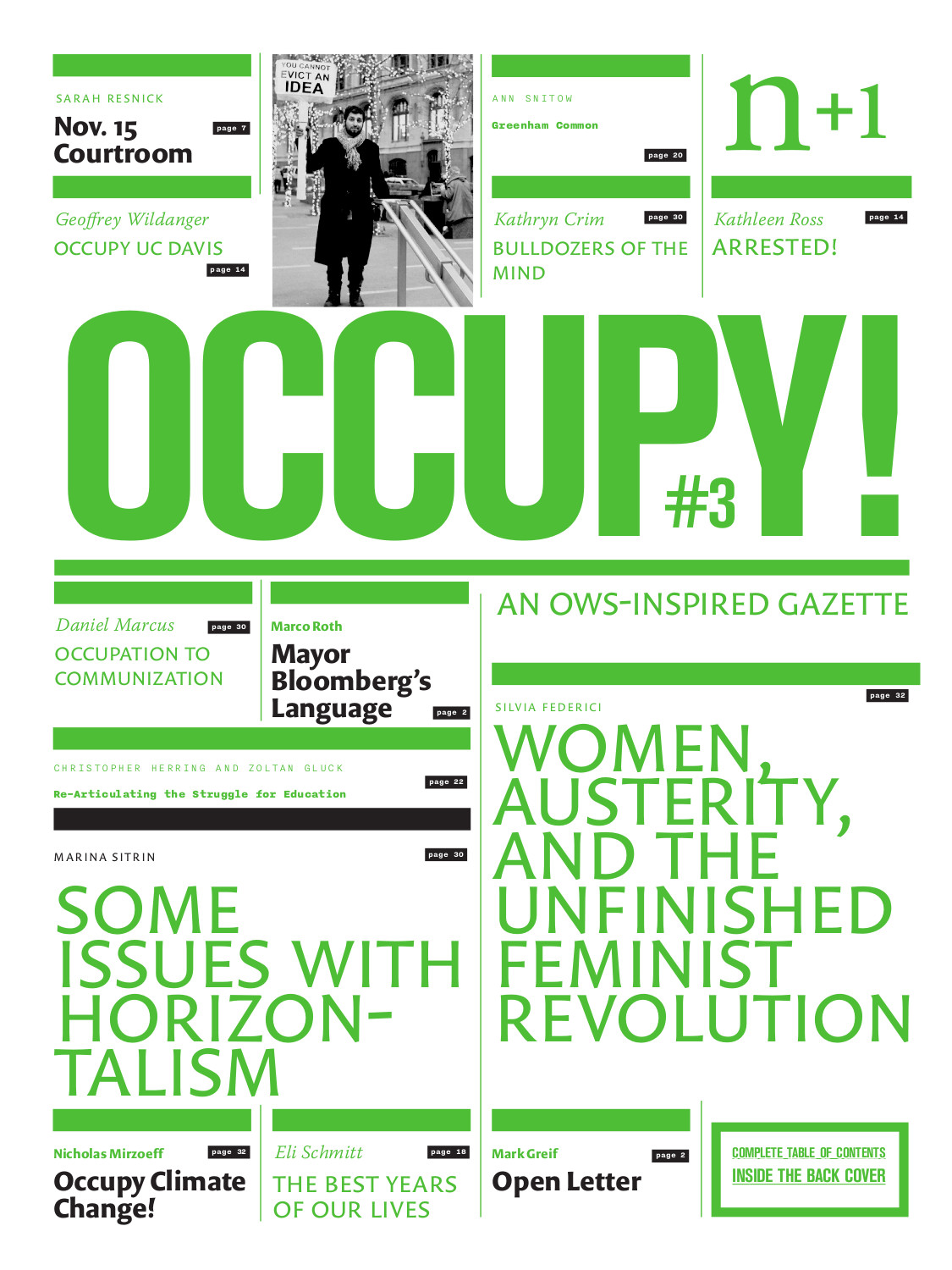Occupy! An OWS-Inspired Gazette, 2-3 (2011)
Filed under magazine | Tags: · activism, debt, economy, money, occupy movement, politics, protest


“Published on November 14, at the beginning of the national wave of evictions, the second Occupy Gazette! completes our history of the first phase of the movement. Articles document the Oakland raid and general strike, emergence of the spokes council, and last days of the Zuccotti Park occupation, and address questions related to homelessness, police relations, and nonviolence, and more.
Published on December 15, the third issue of the Occupy! Gazette is the latest in the series. It describes and re-imagines the movement after the end of the occupations as well as looks to the archives for models. Articles follow student activism from CUNY to Berkeley, cover the Oakland port shutdown, consider the legacies of ACT-UP, the Greenham Common occupation, and autonomia—and more.”
Edited by Astra Taylor, Eli Schmitt, Nikil Saval, Kathleen Ross, Sarah Resnick, Sarah Leonard, Mark Greif, Keith Gessen, and Carla Blumenkranz
Publisher n+1, New York, November and December 2011
2x 40 pages
Issue 2 (updated on 2017-12-2)
Issue 3 (updated on 2017-12-2)
See also Issue 1.
Comment (0)Micah L. Sifry: WikiLeaks and the Age of Transparency (2011)
Filed under book | Tags: · activism, blogging, democracy, facebook, google, internet, transparency, twitter, web 2.0, wikileaks, youtube

The United States government is diligent—some might say to the point of obsession—in defending its borders against invaders, be they terrorists, natural disasters, or illegal immigrants. Now we are told a small, international band of renegades armed with nothing more than laptops presents the greatest threat to the U.S. regime since the close of the Cold War. WikiLeaks’ release of a massive trove of secret official documents has riled politicians from across the spectrum. The WikiLeaks organizers themselves “are going to have blood on their hands” (U.S. Sen. Joe Lieberman), it is the “9/11 of world diplomacy” (Italian Foreign Minister Franco Frattini), they present “a clear and present danger to the national security of the United States” (U.S. Congressman Peter King). Even noted free-speech advocate Floyd Abrams says that WikiLeaks founder Julian Assange “may yet have much to answer for” and blames him for the certain defeat of federal shield-law legislation protecting journalists. Hyperbole, hysteria? Certainly. We heard much the same in 1971, when Daniel Ellsberg released the Pentagon Papers to the New York Times (ironically, Abrams was the Times’ lawyer in that case).
Welcome to the Age of Transparency. But political analyst and writer Micah Sifry argues that WikiLeaks is not the whole story: it is a symptom, an indicator of an ongoing generational and philosophical struggle between older, closed systems, and the new open culture of the Internet. “What is new,” he writes, “is our ability to connect, individually and together, with greater ease than at any time in human history. As a result, information is flowing more freely into the public arena, powered by seemingly unstoppable networks of people all over the world cooperating to share vital data and prevent its suppression.” Despite Assange’s arrest, the publication of secret documents continues, and websites replicating WikiLeaks’ activities have sprung up in Indonesia, Russia, the European Union, and elsewhere. As Sifry shows, this is part of a larger movement for greater governmental and corporate transparency: “when you combine connectivity with transparency—the ability for more people to see, share and shape what is going on around them—the result is a huge increase in social energy, which is being channeled in all kinds of directions.”
Preface by Andrew Rasiej
Publisher OR Books, 2011
ISBN 1935928317, 9781935928317
211 pages
PDF (EPUB; updated on 2012-7-17)
Comments (3)Eric Kluitenberg: Legacies of Tactical Media: The Tactics of Occupation: From Tompkins Square to Tahrir (2011)
Filed under book | Tags: · activism, culture jamming, media activism, media art, politics, protest, social movements, tactical media

Tactical Media employ the ‘tactics of the weak’ to operate on the terrain of strategic power by means of ‘any media necessary’. Once the rather exclusive practice of politically engaged artists and activists, the tactical appropriations of media tools and distribution infrastructures by the disenfranchised and the disgruntled have moved from the margins to centre stage. The explosive growth of mass participation in self-mediation incountless blogs, video sharing platforms, micro-blog ging, social networking has created an unprecedented complexity in the info-sphere.
While this frenzy of media activity has been heralded as the catalyst of the new democratisation movements in North-Africa and the Middle-East, the anti-austerity/precarity movements in Southern Europe and the UK, and the recent #occupy movements in the US and Northern Europe, its increasingly intransparent complexity combined with the post 9/11 ‘crash of symbols’ has thrown its political efficacy into question. The demise of WikiLeaks as the crown jewel of on-line whistle-blowing has added to a thoroughly opaque picture.
More than ever tactical media operators require effective instruments to the create tactical cartographies they need to navigate the hybrid realities they are immersed in. This notebook traces the legacies of tactical media to begin creating these hybrid cartographies.
Publisher Institute of Network Cultures, Amsterdam, 2011
Network Notebooks 05
ISBN/EAN 978-90-816021-8-1
57 pages

